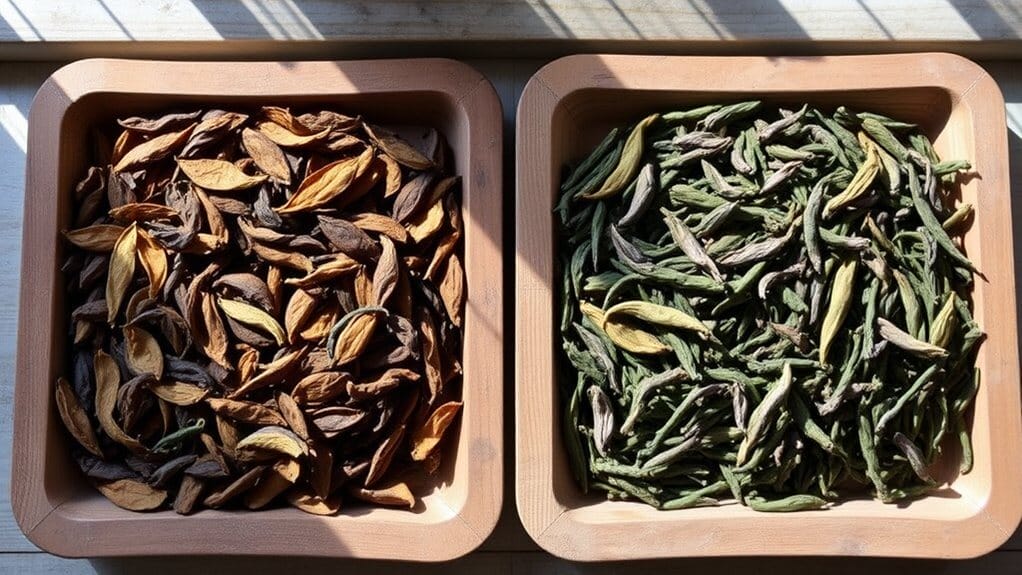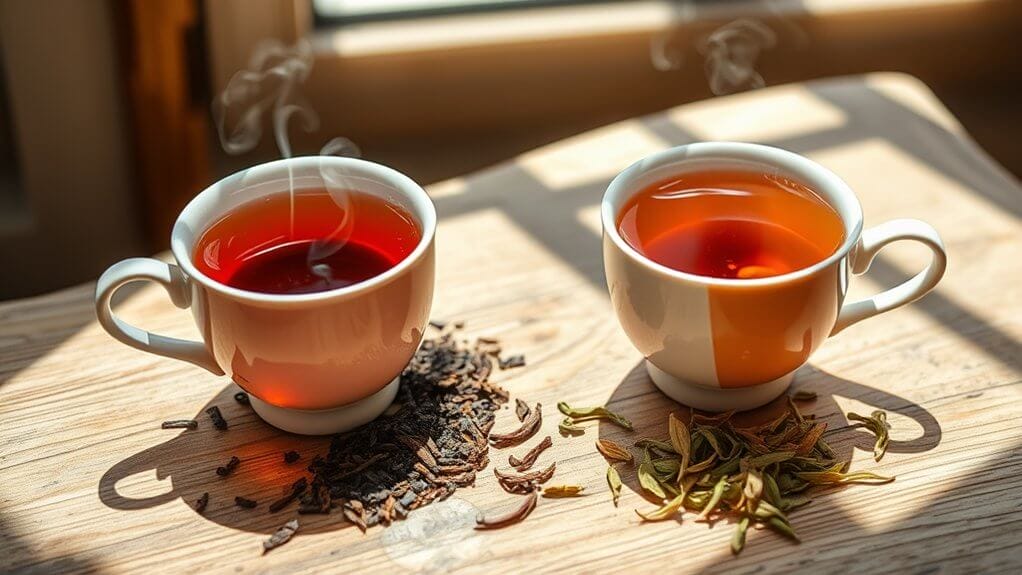Assam and Darjeeling teas offer distinctly different experiences for tea lovers. Assam's low-lying valleys produce a bold, malty tea perfect for breakfast blends, while Darjeeling's misty Himalayan heights create a delicate, muscatel flavor known as "The Champagne of Teas." Assam's robust character pairs well with milk and sugar, whereas Darjeeling's subtle complexities shine best when served plain. These iconic Indian teas hold fascinating stories in their leaves, from their unique processing methods to their health benefits.
Key Points
- Assam tea has a bold, malty flavor ideal for breakfast blends, while Darjeeling offers delicate, muscatel notes known as "Champagne of Teas."
- Assam grows in low-lying valleys (45-60m elevation) with tropical climate, whereas Darjeeling thrives in cooler Himalayan foothills (up to 1,750m).
- Assam tea works well with milk and sugar, but Darjeeling is best enjoyed plain to appreciate its subtle complexities.
- Assam is widely available and affordable (₹125-800/kg), while Darjeeling commands premium prices (up to ₹1,600/500g) with limited production.
- Both teas undergo similar processing methods, but Assam uses mechanized techniques while Darjeeling maintains traditional manual processing.
The Origins and Growing Regions

While both teas hail from northeastern India, Assam and Darjeeling black teas emerge from distinctly different terrains that shape their unique characteristics. Assam's tea cultivation thrives in the low-lying Brahmaputra Valley, where hot, humid conditions and rich loamy soil create an ideal environment at 45-60 meters above sea level. The indigenous tea plant Camellia sinensis assamica was discovered here in 1815, revolutionizing British tea trade. In contrast, Darjeeling's estates spread across seven valleys in the Himalayan foothills, reaching elevations up to 1,750 meters in a cool, misty microclimate. Today, eighty tea gardens continue to produce Darjeeling's prized leaves across the region.
Both regions have earned geographical indications status, recognizing their distinctive origins, with Darjeeling securing additional protected status in the EU, USA, and Australia. The scale of production differs markedly: Assam's vast 312,210 hectares of tea gardens dwarf Darjeeling's more modest 17,820 hectares, yet each region produces teas with inimitable qualities. Darjeeling produces nearly 10 million kg of tea annually, only 1% of India's tea output.
A Tale of Two Flavors: Taste and Aroma

The distinct growing regions of Assam and Darjeeling directly influence their signature flavor profiles, creating two remarkably different tea experiences. Assam tea delivers a bold, malty character with rich notes of cocoa and caramel, making it perfect for traditional breakfast blends and milk-based preparations. Its robust nature and higher caffeine content offer an energizing morning cup. The tea's dark brownish color makes it instantly recognizable in the cup. The high humidity levels of Assam's tropical climate contribute significantly to the tea's full-bodied characteristics.
In contrast, Darjeeling's flavor profiles and aroma nuances are more delicate and complex. Often called "The Champagne of Teas," it exhibits a distinctive muscatel flavor with subtle vegetal and citrus undertones. The tea's character varies considerably by harvest season, with first flush teas presenting light, floral notes, while second flush varieties develop fuller, wine-like qualities. Unlike Assam, Darjeeling's subtle complexities are best appreciated without milk. The tea's three seasonal flushes throughout the growing season contribute to its diverse flavor offerings.
From Harvest to Cup: Processing Methods

Both Assam and Darjeeling teas undergo meticulous processing steps that transform freshly picked leaves into their distinctive final forms. The process begins with withering techniques, where leaves are spread on Hessian cloth over wire-mesh racks for about 12 hours until they're flaccid with 4% moisture content. Next, rolling methods involve crushing and tearing the leaves into small particles using specialized equipment, preparing them for oxidation. Each procedure takes place in climate-controlled rooms to ensure consistent quality throughout the process.
The oxidation duration typically ranges from one to two hours, during which the leaves develop their characteristic reddish-brown color and flavor profiles. The process concludes with firing temperatures reaching 270°F, which halts oxidation and reduces moisture content to 3%. While Assam processing relies more on mechanization, Darjeeling's hillier terrain necessitates traditional, manual methods, contributing to each tea's unique characteristics. Women tea pluckers play a crucial role in maintaining quality standards during harvesting, carefully selecting the finest leaves for processing. Quality control is paramount as the entire processing must be completed within 24 hours of leaf collection to maintain the tea's optimal characteristics.
Health Benefits and Wellness Properties

Beyond their distinct processing methods, Assam and Darjeeling teas offer remarkable health benefits that have made them popular choices among wellness enthusiasts. Both varieties excel in providing immune support through their rich antioxidant properties, though they shine in different areas of health promotion.
Assam tea stands out for its significant impact on heart health and blood sugar regulation, while also containing compounds that may inhibit cancer cell growth. It's particularly noted for improving cognitive function and dental health through its fluoride content. Research suggests that Assam tea's potent antioxidant compounds actively fight harmful free radicals in the body. Regular consumption promotes skin vitality through its natural vitamins A and E content. Darjeeling tea boosts metabolism through its rich catechin content, making it particularly effective for weight management goals. Darjeeling tea, meanwhile, excels in supporting weight management and digestion. It's especially valued for its stress-reducing properties and ability to promote cardiovascular health by improving blood flow. Both teas contribute to overall wellness, making them excellent additions to a healthy lifestyle.
Quality, Cost, and Market Availability

When examining quality and market dynamics, Assam and Darjeeling teas present distinct characteristics that influence their cost and availability. Assam tea offers a robust, malty flavor profile and is widely accessible due to its large-scale production, with prices ranging from ₹125 to ₹800 per kilogram. Its full-bodied nature makes it a popular choice for breakfast blends. The tea thrives in rich clayey soil that contributes significantly to its distinctive characteristics. The climate's hot and humid conditions create ideal growing conditions year-round. The Satrupa CTC blend exemplifies this accessibility with its hearty malty flavor making it an excellent choice for daily consumption.
In contrast, Darjeeling tea commands higher pricing trends due to its limited production and unique growing conditions. Known for its delicate muscatel flavor and floral aroma, Darjeeling tea can cost up to ₹1,600 for 500 grams, especially for first flush varieties. While Assam tea is readily available year-round in various forms, Darjeeling tea is often found in specialty stores and appeals to connoisseurs seeking its distinctive seasonal characteristics.
Conclusion
Darjeeling and Assam teas stand as India's crowning achievements in the world of black tea, each telling its own story through distinct flavors and aromas. While Darjeeling whispers of floral notes and muscatel grapes from misty Himalayan slopes, Assam thunders with bold, malty richness from fertile river valleys. They're both exceptional in their own right, offering tea lovers a choice between delicate sophistication and robust intensity.
















